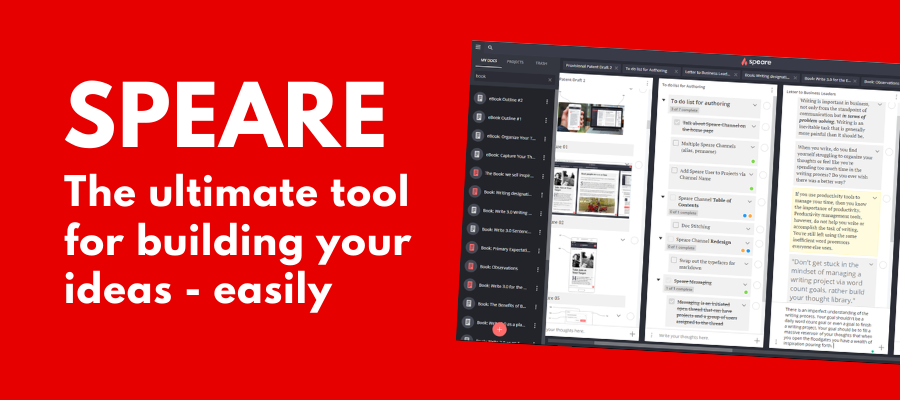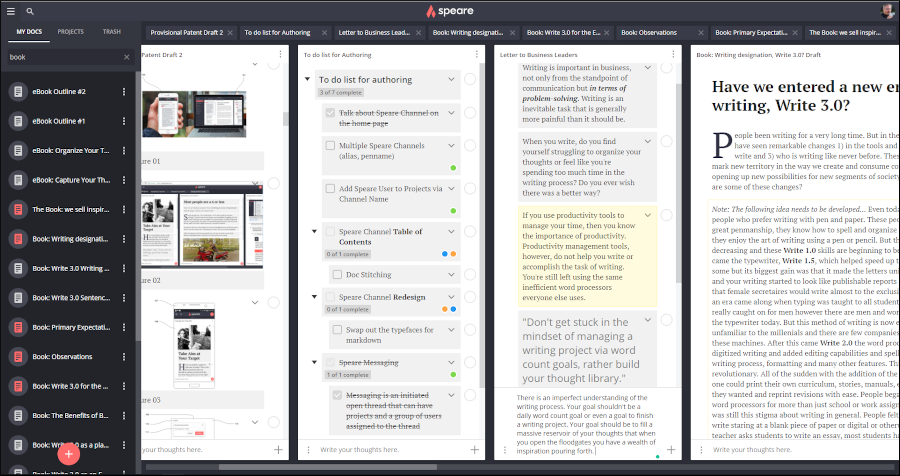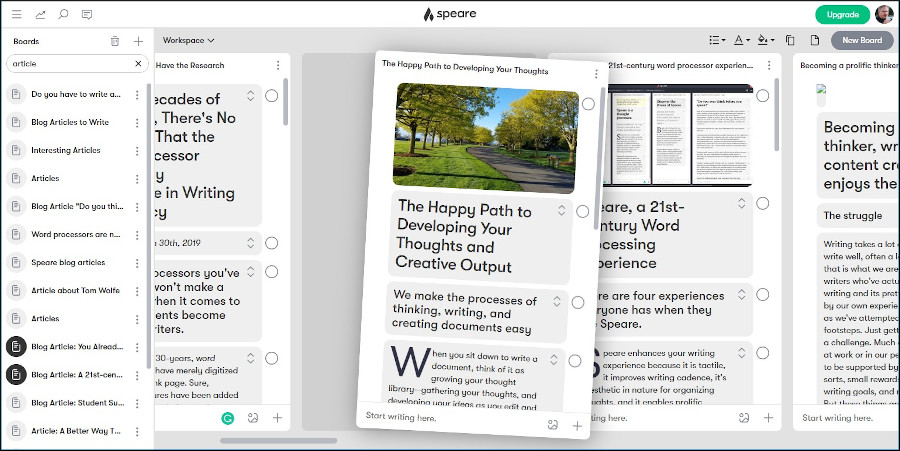
Imagine if you had a Lego set that enabled you to design any kind of idea “blocks” you could envision, and then quickly and easily assemble them into amazing creations. That’s the thinking behind Speare, a web-based idea processor and writing tool.
Speare enables you to capture your notes, ideas and research, organize them and output them into finished documents quickly and easily, using a visual, building block format.
The building blocks of Speare
Speare is a web-based writing and note-taking tool that differs from text-based applications like Word, Google Docs, Evernote and Notion in a critically important way: Traditional writing applications use the blank page as their organizational metaphor – an approach that has some definite limitations, most notably writer’s block.
In contrast, Speare is organized to support the way your brain thinks and works with ideas. It treats each paragraph and sentence as a building block that is easy to manipulate, move and connect.
Building blocks can be arranged into boards, side-by-side visual panes within the Speare workspace that can contain collections of blocks. They can contain your writing or collections of knowledge, notes and ideas. You can drag and drop content into boards and notes, making it ideal for gathering online research.
 Blocks can contain text, images and even videos. They can be quickly formatted using markdown (a content tagging system used to format web content that works really well in this context), and can be nested into simple hierarchies to structure your information and ideas. Nested hierarchies of ideas can be collapsed to make more room vertically within a board. Speare even enables you to split your notes into individual sentences, which is pretty cool. It’s like a sandbox for playing around with your ideas at an atomic level.
Blocks can contain text, images and even videos. They can be quickly formatted using markdown (a content tagging system used to format web content that works really well in this context), and can be nested into simple hierarchies to structure your information and ideas. Nested hierarchies of ideas can be collapsed to make more room vertically within a board. Speare even enables you to split your notes into individual sentences, which is pretty cool. It’s like a sandbox for playing around with your ideas at an atomic level.
 Although there isn’t a Speare app yet, it does play well in smartphone browsers. That means you can dictate ideas directly into notes in a browser or you can text them to yourself. Speare places incoming notes into a separate queue within the application, so you can drag and drop them into your boards wherever you want. I love this ability to capture ideas any time, anywhere!
Although there isn’t a Speare app yet, it does play well in smartphone browsers. That means you can dictate ideas directly into notes in a browser or you can text them to yourself. Speare places incoming notes into a separate queue within the application, so you can drag and drop them into your boards wherever you want. I love this ability to capture ideas any time, anywhere!
Boards can be dragged and dropped into different sequences and can be shown or hidden in the workspace. They give users the ability to control the arrangement of your thoughts and ideas at a high level. Speare’s search and filtering capabilities enable you to find and gather related ideas into new boards, while retaining a copy of the thoughts in their original locations – nice!
Spaces are collections of boards. They allow you to create and switch between different collections of boards quickly and easily. You can create a space for each major project you’re working on. You can create as many spaces as you need (in the pro version; users can only create one space in the free version).
Speare’s intuitive drag-and-drop functionality makes it easy for you to arrange and rearrange your ideas into cohesive narratives, plans and projects. Once you’ve arranged and edited your building blocks the way you want them, you can compile them into documents in a single click. You can publish it directly to your own personal page on the Speare website or into a “draft” – a permanent document that’s stored within your account. You can, of course, also copy and paste your compiled document into a Word or Google doc, a WordPress blog post and dozens of other text-based applications.
What makes Speare unique?
Most word processing and writing applications were never designed to capture and organize ideas. Their primary purpose is to record your writing. That means content creators must think in complete sentences, paragraphs and narratives, and record their thoughts in a fairly rigid sequence. That’s hard for many business people, entrepreneurs and writers to do – which is one of the reasons that writer’s block is such a common malady.
These existing word processing and writing tools also make it hard to see the structure of your information. It’s hidden in sentences and paragraphs and an endlessly scrolling text experience that can be intimidating to many people.
In contrast, Speare works at the level of ideas, which is much more manageable. It’s ideal for multi-threaded thinkers – people who tend to have multiple streams of thinking going on in their brains at the same time. Like me!
Also, don’t write off Speare as just another writing tool. This elegantly-designed application is perfect for any business owner, entrepreneur or creative person who is looking for a way to capture, refine, improve and share your ideas with others.
My remarkable experience with Speare
Initially, I was a bit skeptical about the benefits of Speare. But I decided the best way to test it would be to use it on a project – a media kit I needed to create for one of my clients.
I interviewed the founder of the company via a Zoom call and captured extensive notes in writing. I then researched the company’s website to glean facts and information about their product. I then dictated, typed and copied and pasted all of this raw content into building blocks in Speare.
I had several documents to prepare: A backgrounder, a fact sheet and a bio, so I created boards for each of them. I was able to easily drag and drop each “chunk” of information into a logical sequence and edit them until I was satisfied with them. Writing and editing in this simplified format made it surprisingly easy to develop a cohesive narrative for each document.
I found the ability to work with multiple boards side-by-side to be especially valuable, because initially it wasn’t clear if some of the information I gathered should appear in the backgrounder or the fact sheet. Speare helped me quickly experiment and make decisions about the information I gathered. The best part: It enabled me to do so without getting in the way of my thinking.
I then used the application’s compile feature to join all of my building blocks together into finished documents – in a fraction of the time it would take me to write them using the conventional method.
One interesting phenomenon I experienced is this: Because you capture your ideas, information, knowledge and wisdom in building blocks, it helps you to be concise in your writing. Less is more.
Speare as a knowledge management tool
As I’ve played around with Speare, I’ve become more and more intrigued with its potential as a personal knowledge management tool. In that sense, it seems to support the principles of Tiago Forte’s Building a Second Brain methodology:
- It enables you to capture a large amount of knowledge and information in bite-sized chunks.
- Its markdown formatting enables you to do progressive summarization – day, for example, turning blocks into comments (which appear with a yellow background) as the first level of summarization and bold text as the second.
- Boards are an approximate equivalent of intermediate packets – collections of thought and ideas that can be distilled, added to or easily published.
Conclusion
If your work involves gathering, organizing, distilling and sharing information, knowledge or learning with others, then you really ought to take a closer look at Speare. I was pleasantly surprised at how efficient and effective its building block approach was in helping me organize my writing.
Pricing varies between US4.95 and $14.97 per month, depending upon whether you select a monthly, quarterly or yearly subscription plan.



Leave a Reply